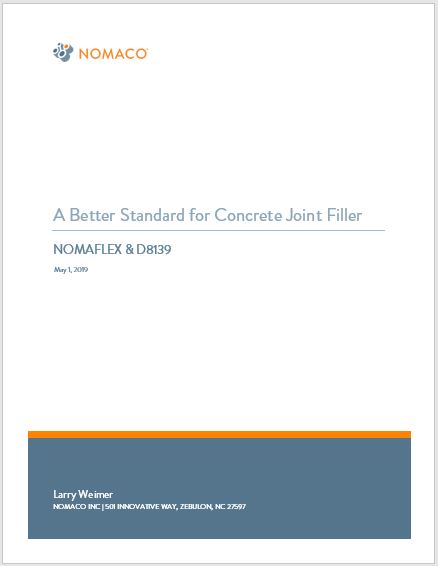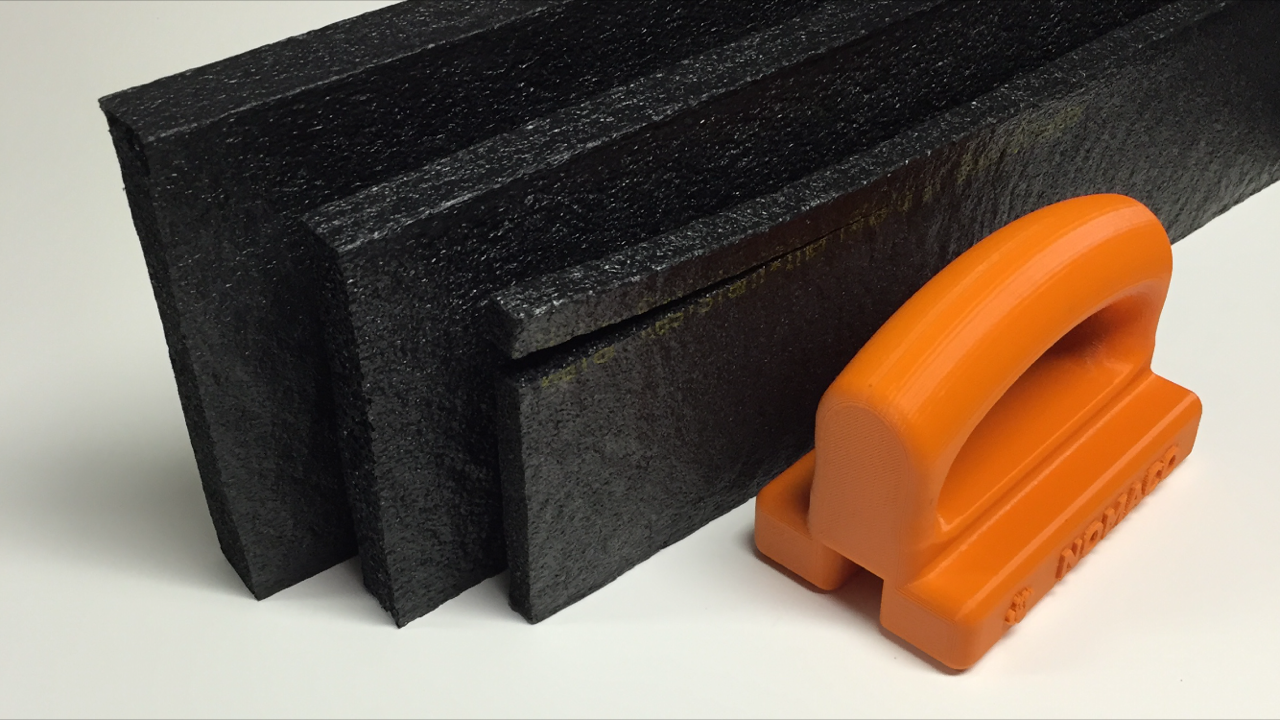by Larry Weimer
Introduction

Since the early 1900s, concrete installers have been commonly using a form of asphalt-impregnated fiberboard (AIFB) as filler in concrete expansion joints. Today there is a new joint filler solution that has raised the bar on the old standards.
Nomaflex is a polypropylene foam joint filler product that is flexible, waterproof, lightweight, odor-free and compatible with hot-pour and cold-applied sealants.
Introduced in 2016, Nomaflex exceeds many existing performance specifications and standards set for traditional AIFB. When asked if Nomaflex meets the following specifications, the answer is, “Why would you want it to?”
- AASHTO M 213
- ASTM D1751
- Corps of Engineers CRD-C 508
- FAA Specification Item P-610-2.7
- HH-F-341 F, Type 1
These specifications describe an inferior material that has not been markedly improved or updated in more than 70 years (original American Society for Testing and Materials (ASTM) Standard D994 specification written in 1948).
The material covered by all of the above specifications is asphalt-impregnated fiberboard (AIFB). In descriptive terms, AIFB is a joint filler made of compressed cellulosic-based fibers saturated with an asphalt binder that acts as a bonding agent and provides some moisture resistance.
Physical Property Considerations
There are six physical property requirements that further define AIFB joint filler material by these specifications. These requirements are listed below, however, there are only three on the list that are truly important (*) for a material to properly function as a joint filler in concrete expansion or isolation joints.
| 1. | Asphalt Content | > 35% |
| 2. | Density | > 18 lbs./ft3 |
| 3. | Compression Strength | 750 – 1250 psi |
| 4. | Compression Recovery* | > 70% |
| 5. | Water Absorption* | < 15% |
| 6. | Extrusion* | < 0.25 in. |
Since the three primary purposes of an expansion/isolation joint filler are 1) to completely separate one slab from another, 2) expand and contract with the movement of the concrete during thermal cycles, and 3) keep incompressible material from entering the joint, a closer look at the above requirements will clearly show why a modification to the project specification should be considered.
Although the minimum requirement for Asphalt Content in AIFB is 35%, this is actually a “catch 22” for the AIFB manufacturers. Low levels of Asphalt can cause poor bonding with less moisture resistance, and high levels of asphalt will cause residual staining of the concrete and/or impact sealant performance, and most noteworthy, add cost. This may explain why there is much inconsistency with adherence to the requirement when tested by independent or agency labs. Either way, the end customer loses.
Benefits of New Material

On the other hand, Nomaflex is made of closed-cell polypropylene foam, which does not require an asphalt binder or any other bonding agent for cohesive strength. Nomaflex simply will not come apart like AIFB, and it will not absorb water. Clearly, Asphalt bonding agents offer no advantages relative to the primary purposes of expansion joint filler and meeting this specification is NOT relevant for Nomaflex.
With a Density of 18 lbs/ft3 or more, AIFB is obviously a heavier material. However, this can be a potential back-breaker for construction crews, along with a number of related handling challenges on the job site. Ironically, density is not a key physical property relative to performance as a joint filler. Materials with densities as low as 1.5 lbs/ft3 have proven to be very effective in both expansion and isolation joint filler applications for many years. In fact, lower density materials generally have better expansion and contraction characteristics keeping the space in the joint filled. So why carry the weight? Nomaflex is resilient, lightweight and easy to handle with an ideal density of approximately 4 lbs/ft3.
Compression Strength & Recovery
Compression Strength of AIFB falls within a wide range of 100 to 750 psi of pressure required to squeeze it to 50% of the original thickness. Although AIFB offers resistance to compression as the concrete is poured, it surely will not expand as the concrete contracts, leaving space for dirt and debris to enter the joint and potentially wear away at the joint substrates. In addition, it provides very little give as it goes through thermal expansion cycles. This will lead to a breakdown of the filler material, more debris and more spalling around the joint. On the other hand, Nomaflex provides adequate resistance during the concrete pour, paired with ideal compression resistance or “give” that will allow for thermal expansion of the concrete without breaking down the filler. It will continue to prevent debris from entering the joint before, during and after each thermal expansion cycle.
An expansion or isolation joint filler’s compression strength must compliment one of the most important physical properties for optimal performance, which is Compression Recovery. The material must expand and contract with the movement of the concrete to keep debris and non-compressibles out of the joint. At best, AIFB will recover about 70% of its original thickness after 50% compression. Clearly, this 30% void will allow dirt, debris and other non-compressible materials to enter the joint, which eventually tears away at the concrete. Conversely, Nomaflex provides more than 80% recovery after 50% compression providing superior results through the ongoing and seasonal thermal expansion and contraction cycles. Moreover, it will not fragment or flake away during these cycles like AIFB. Nomaflex keeps debris out and stays in place.
Water Absorption
Water Absorption resistance is an extremely important trait that joint filler materials should possess. The above standards actually allow AIFB to absorb water up to 15% by volume in a 24-hour period.  This would surely lead to problems after a season of rain or melting snow. The filler would be completely saturated, likely swell and separate, and the fibers would gradually wash away. In freezing climates, the saturated AIFB will likely pose the additional risk of spalling as the trapped water turns to ice, expands, and forces non-compressible debris against the substrate. Alternately, Nomaflex is waterproof. It is composed of closed-cell polypropylene foam, which will not absorb water, become saturated or swell. Polypropylene foam is actually freeze-thaw resistant with a usage temperature range of – 200 deg. F through + 400 deg. F.
This would surely lead to problems after a season of rain or melting snow. The filler would be completely saturated, likely swell and separate, and the fibers would gradually wash away. In freezing climates, the saturated AIFB will likely pose the additional risk of spalling as the trapped water turns to ice, expands, and forces non-compressible debris against the substrate. Alternately, Nomaflex is waterproof. It is composed of closed-cell polypropylene foam, which will not absorb water, become saturated or swell. Polypropylene foam is actually freeze-thaw resistant with a usage temperature range of – 200 deg. F through + 400 deg. F.
Non-Extruding
Non-Extruding or not sticking out of the joint when compressed is yet another important physical property. Poor performance will certainly affect pedestrian safety, filler life, and sealant adhesion. If the filler material were to protrude out of the joint when compressed during thermal expansion cycles, it could potentially create a tripping hazard, cause adhesive failure of the sealant at the concrete substrates, and promote wear and tear on the filler material. Although AIFB is considered a non-extruding material, it will still extrude up to 1/4 inch when compressed to 50%. If you add swelling from moisture absorption, it is easy to understand why joint maintenance is an ongoing concern when AIFB is used. Once again, Nomaflex offers superior results. It puts the “non” back into non-extruding with a range of 0 – 0.019-inch extrusion at 50% compression.
Critical Properties
Interestingly, the listed specifications DO NOT address a number of other very important physical properties that are critical for successful joint filler performance. This would include:
- UV Weathering
- Freeze-Thaw Resistance
- Heat Resistance
- Chemical Resistance
- Sealant Compatibility
By contrast, Nomaflex has been evaluated and tested by AASHTO APEL, Independent Labs, and numerous sealant manufacturers for positive performance in each of these categories. No other joint filler material has been scrutinized to this level. The real question should be: Why do the above specifications not address all of the important physical properties for joint filler performance?
New Standard
Today, there is a more stringent concrete construction standard in ASTM D8139.
This Standard Specification for Semi-Rigid, Closed-Cell Polypropylene Foam, Preformed Expansion Joint Fillers for Concrete Paving and Structural Construction was published in 2017 and sets rigorous requirements, test methods and tolerances that polypropylene foam joint fillers must adhere to when specified in construction.
ASTM D8139 requires more rigorous tests than existing standards for joint fillers such as D1751 “Standard Specification for Preformed Expansion Joint Filler for Concrete Paving and Structural Construction (Nonextruding and Resilient Bituminous Types).” The additional testing and physical property requirements to meet the new standard include UV Resistance, Freeze-Thaw Resistance, and Heat Resistance. The new standard also dictates less extrusion, higher compression recovery, and significantly less water absorption than required for D1751 compliance.
Superior Performance
Clearly, when an architect or engineer is looking for superior performance in an expansion and isolation joint filler, and considers the physical properties that are actually critical to long-term performance; his or her basis of design should be Nomaflex and the new ASTM D8139.
For more information, visit www.nomaco.com/nomaflex.

